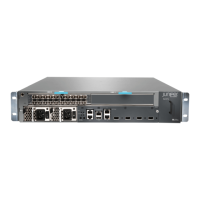CHAPTER 1
Overview
•
System Overview on page 19
•
MX5, MX10, MX40, and MX80 Chassis on page 24
•
MX5, MX10, MX40, and MX80 Power System on page 31
•
MX5, MX10, MX40, and MX80 Host Subsystem on page 42
•
MX5, MX10, MX40, and MX80 Interface Modules on page 43
System Overview
•
MX5, MX10, MX40, and MX80 Router Overview on page 19
•
MX5, MX10, MX40, and MX80 Router Models on page 22
•
MX5, MX10, MX40, and MX80 Hardware Components and CLI Terminology on page 23
MX5, MX10, MX40, and MX80 Router Overview
The Juniper Networks MX5, MX10, MX40, and MX80 Universal Routing Platforms are
Ethernet-optimized edge routers that provide both switching and carrier-class Ethernet
routing. The MX5, MX10, MX40, and MX80 routers run Junos operating system (Junos
OS), enabling a wide range of business and residential applications and services, including
high-speed transport and virtual private network (VPN) services, next-generation
broadband multiplay services, and high-volume Internet data center internetworking.
Each router provides full duplex, high-density Ethernet interfaces and high- capacity
switching throughput and uses the Junos Trio chipset for increased scalability of L2/L3
packet forwarding, buffering, and queuing.
•
Benefits of the MX5, MX10, MX40, and MX80 Router on page 19
•
MX5, MX10, MX40, and MX80 Hardware Overview on page 20
Benefits of the MX5, MX10, MX40, and MX80 Router
•
System Capacity—The MX80, MX40, MX10, and MX5 routers are software upgradeable
from 20 Gbps to 80 Gbps. These platforms have up to four Modular Interface Card
(MIC) slots and two fixed 10-Gigabit Ethernet interfaces for connecting to the network.
•
Always-on infrastructure base—MX Series routers ensure network and service
availability with a broad set of multilayered physical, logical, and protocol-level resiliency
aspects. Junos OS Virtual Chassis technology on MX Series routers supports
chassis-level redundancy and enables you to manage two routers as a single element.
19Copyright © 2019, Juniper Networks, Inc.

